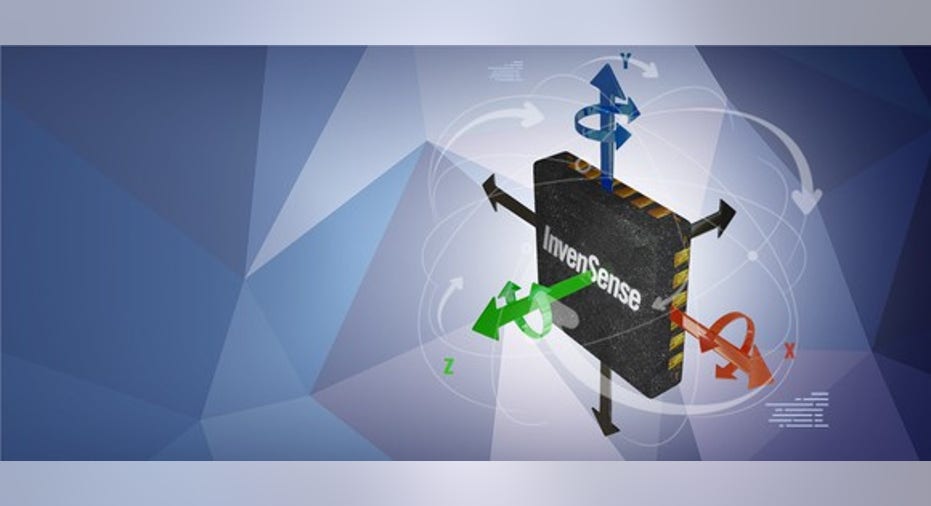Which of These Companies Could Buy InvenSense?

Chipmaker InvenSense (NYSE: INVN) is reportedly interested in selling itself, according tomultiple reports citing unnamed sources. InvenSense supplies motion sensors to Apple (NASDAQ: AAPL), Samsung, and other mobile-device makers, but it's had a rough year because of rising competition and sluggish smartphone sales.
Image source: InvenSense.
Analysts expect the chipmaker's revenue to fall24% this year, compared with 47% growth in2015. Those bleak expectations sent the stock tumbling almost 40% over the past 12 months. With an enterprise value of just over $600 million, InvenSense now has an enterprise value-to-sales ratio of 1.6, making it a fairly cheap purchase for companies interested in its "best-in-breed" motion sensors -- accelerometers and gyroscopes. Let's take a closer look at the three most likely suitors for the struggling chipmaker.
STMicroelectronics
Chipmaker STMicroelectronics (NYSE: STM), which competes directly against InvenSense in the motion-sensor market, could buy InvenSense to become the undisputed market leader in gyroscopes and accelerometers. With $1.68 billion in cash and equivalents at the end of last quarter, STMicro could theoretically acquireInvenSense in an all-cash transaction.
STMicro previously supplied Apple withmotion sensors for its iPhones, but InvenSense won that spot from the iPhone 6 onward. STMicro struck back at InvenSense by supplying the motion sensor for the Apple Watch, but Apple still apparently usesInvenSense sensors in the iPhone 7.
Image source: Apple.
By gobbling up InvenSense, STMicro would become Apple's primary supplier of gyroscopes and accelerometers, regardless of which brand the iPhone maker picks. But there's also a risk that Apple -- not wanting to let a single supplier gain too much clout -- could start buying its motion sensors from STMicro and Invensense's rival Bosch instead.
Sony
InvenSense would also be a good fit for Sony (NYSE: SNE), which could use its motion sensors to complement its camera, image sensor, and Internet of Things (IoT) businesses. It would be a fairly cheap purchase for Sony, which finished last quarter with $5.2 billion in cash andequivalents.
InvenSense is mainly known for its smartphone motion sensors, but it also supplies optical image stabilization sensors for cameras. Sony produces its ownoptical image stabilization sensors, but that unit could benefit from merged technologies and the inclusion of InvenSense's customer list.
InvenSense also has a rapidly growing IoT business, which provides motion sensors for wearables, drones, and other devices. That unit would directly complement Sony's acquisition of IoT 4G chipmaker Altair earlier this year and enable it to grow its content share across various connected devices. Integrating InvenSense's motion sensors could also help Sony tighten up the supply chain and reduce operating costs at its mobile unit -- the same reason Apple and Samsung use first-party silicon in many of their own devices.
Intel
Intel (NASDAQ: INTC), the world's top manufacturer of PC and data center chips, has been stuck in a rut because of weak growth in both markets. Its inability to penetrate the mobile market also forced it to seek growth in other markets, such as IoT modules, programmable chips, non-volatile memory, and depth-sensing cameras.
One of Intel's key strategies to expand beyond PCs and data centers is to create all-in-one "reference designs" that enable OEMs to quickly create devices such as drones and VR headsets. These designs bundle together Intel's chips, RealSense depth-sensing cameras, and other first-party components to widen its moat against larger rivals.
Intel's Project Alloy. Image source: Intel.
Intel's VR/AR headset reference design, a standalone device dubbed "Project Alloy," is powered by Intel's sixth-generation Core processor andRealSense camera. It's unclear who supplied the gyroscopes and accelerometers, but Intel could certainly beef up that bundle with InvenSense's sensors. The same could also be said about Intel's reference designs for drones or other IoT gadgets. With $17.8 billion in cash and equivalents at the end of last quarter, InvenSense would bea bite-sized purchase for Intel.
But will InvenSense actually be acquired?
It makes strategic sense for STMicro, Sony, or Intel to buy InvenSense, but it's also logical to simply wait for InvenSense to become cheaper. With sales slipping and the company struggling to defend its moat against bigger rivals, it seems InvenSense could become even cheaper over the next few quarters. Therefore, investors shouldn't buy InvenSense with the expectation that it could be acquired in the near future.
A secret billion-dollar stock opportunity The world's biggest tech company forgot to show you something, but a few Wall Street analysts and the Fool didn't miss a beat: There's a small company that's powering their brand-new gadgets and the coming revolution in technology. And we think its stock price has nearly unlimited room to run for early in-the-know investors! To be one of them, just click here.
Leo Sun has no position in any stocks mentioned. The Motley Fool owns shares of and recommends Apple. The Motley Fool owns shares of InvenSense and has the following options: long January 2018 $90 calls on Apple and short January 2018 $95 calls on Apple. The Motley Fool recommends Intel. Try any of our Foolish newsletter services free for 30 days. We Fools may not all hold the same opinions, but we all believe that considering a diverse range of insights makes us better investors. The Motley Fool has a disclosure policy.